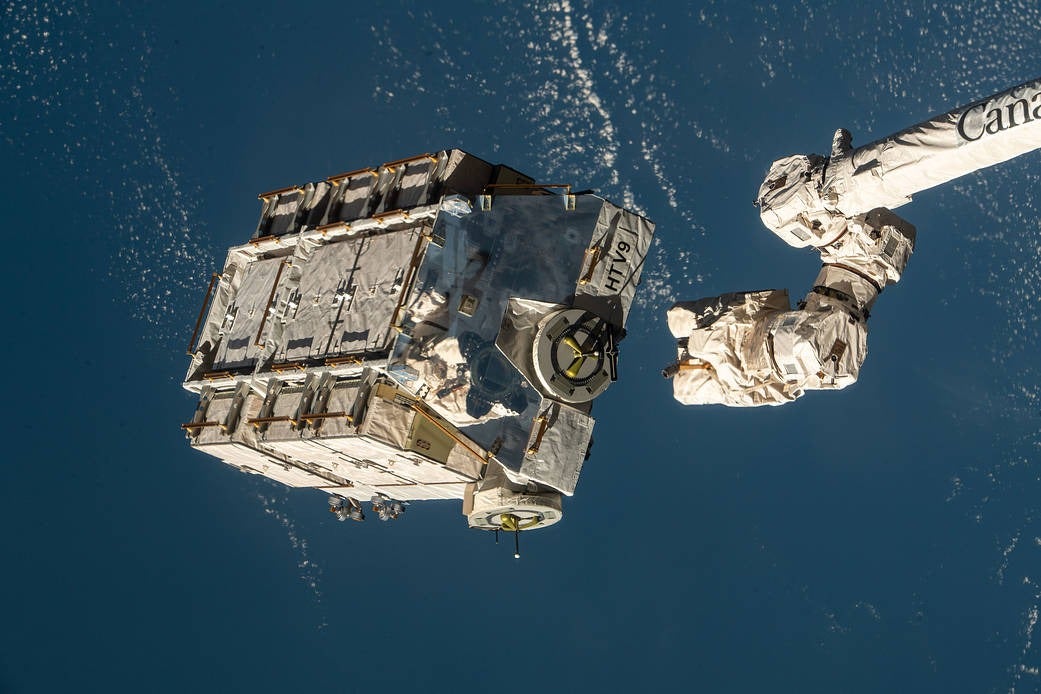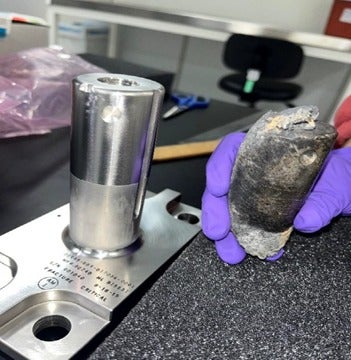
Early last month, a hunk of metal crashed into a Florida home and tore through two floors before it punctured the floor, missing the homeowner’s son by two rooms. A home security camera recorded the crash at 2:34 pm local time (19:34 UTC) on March 8; five minutes prior, the U.S. Space Command cataloged the reentry of a space debris into Earth’s atmosphere over the Gulf of Mexico, heading toward Florida.
Over a month after the incident, NASA announced on April 15 that the cylindrical object was indeed a remnant of an SUV-sized pallet of old batteries that was discarded from the International Space Station (ISS) in 2021, by far the biggest object jettisoned from the ISS for an uncontrolled reentry.
The pallet had been transported to the ISS the previous year on a Japanese cargo ship and fitted with 5,800 pounds (2,630 kilograms) of batteries soon after. Although it was originally supposed to return to Earth in a controlled, predictable manner, the pallet could only fit in Japanese cargo ships, the last of which departed the ISS in 2020, thus stranding the depleted batteries on ISS with no scheduled ride back to Earth. When NASA threw the pallet overboard in 2021, it had estimated that the dispensed pallet would whiz around Earth for two to four years “before burning up harmlessly in the atmosphere.” While most of it disintegrated in the eastern part of the Gulf of Mexico, it left behind the dense, 1.6 pound (0.7 kilograms) metal fragment that invaded the Florida home.
The incident has sparked fresh concerns about the acceptable risk for uncontrolled reentries of human-made space junk in the increasingly crowded low-Earth orbit and the murky realm of international space law.
“We are becoming a space-dependent civilization,” says Mojtaba Akhavan-Tafti, an assistant research scientist at the University of Michigan, who is leading a project to identify and track minuscule space debris. “That’s why international laws matter — that’s something we significantly lack today.”

The landing zone
At least once every few months, Earth’s atmosphere witnesses incoming human-made debris weighing several tons, many of which vaporize before reaching the surface. A handful of rare items that didn’t disintegrate were previously spotted in largely isolated areas, like the dagger-shaped SpaceX capsule that crashed in an Australian farm in 2022 and the Chinese rocket stage that littered across the Ivory Coast in 2020. The exception to these benign reports was a 1997 incident in Oklahoma where a 6-inch fragment of a spent rocket struck a woman. She was unharmed, and to date is the only known human to have been hit by space debris.
“But when you do this for 50 years, eventually you’re gonna get unlucky,” says Jonathan McDowell, a Smithsonian astronomer in Massachusetts who tracks atmospheric reentries. “We’ve had thousands of reentries over the course of the Space Age, so the cumulative risk starts to be significant.”
Unlike large objects that usually have a rocket engine that can be restarted to direct them to drop into oceans, the ISS pallet was left in orbit for an “uncontrolled” reentry into Earth’s atmosphere – “uncontrolled” meaning “you can’t tell where it’s going to finally break up,” says McDowell. The ISS zips around the Earth in a circular orbit 250 miles (400 kilometers) above the surface, so a piece of debris thrown overboard from the ISS would start off at the same orbit and shrink rapidly over time due to the headwind of our planet’s atmosphere. Scientists tracking it can predict its reentry into the atmosphere as much as twelve hours in advance. “But in 12 hours, it goes four times around the Earth,” says McDowell. “That’s a lot of uncertainty about where it’s gonna come down.”
Equally difficult to predict is whether a piece of space debris will burn up in Earth’s atmosphere and how much may be left. Scientists try to predict an object’s fate using computer simulations that show which materials heat up and break apart during reentry. Reports of space junk on the ground show those models haven’t always been fully accurate. In the latest incident, NASA said it will investigate the cause of debris survival and update its models accordingly.
“We got a lot more careful about the 10-ton class objects, but still we’re fairly cavalier about the 1-ton, 2-ton objects,” says McDowell. “That norm is slowly evolving to be stricter and stricter, and this incident will push it a little further.”
Space traffic
As per the Outer Space Treaty of 1967, no nation owns space. So with over 170 million pieces of space debris already drifting in orbit around Earth and at least 1 million satellites in the books, questions remain about who is responsible for clearing up the trash. These objects, only 1 percent of which are tracked, pose an immediate threat to functioning satellites as well as space-based telescopes and the ISS, with unpredictable risks to airliners and residential areas during their reentry into Earth’s atmosphere.
The U.S. has tackled some of that issue. For instance, in September 2022, the U.S. Federal Communications Commission (FCC) adopted a rule which requires operators to deorbit their spent satellites within five years, shrinking the timeline from 25 years. Then in October last year, it issued the first-ever fine related to space debris, $150,000 to a satellite operator who failed to safely dispose of a retired satellite.
Another emerging concern, for which no solution is yet available, is the vaporized metal from spent rockets and satellites recently found polluting Earth’s ozone-hosting stratosphere, including silver, nickel, titanium, and other materials that are not known to form naturally in Earth’s air.
“The answer could still turn out to be [that] it’s not a big deal,” says McDowell. “But the early hints are that it might be bad.”









